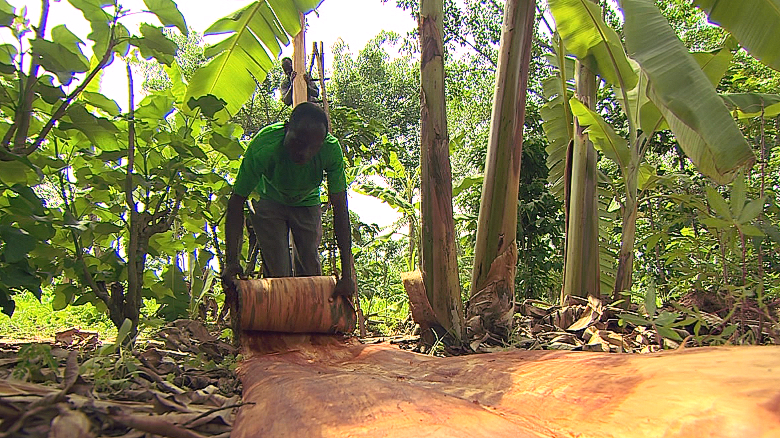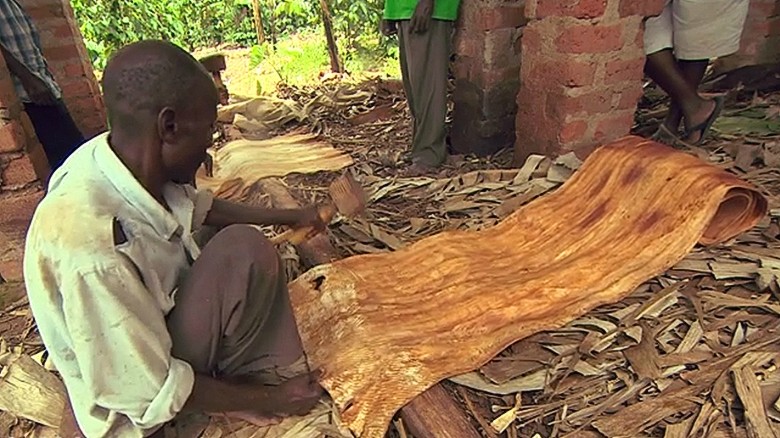Tree bark on the runway? How Uganda is turning heads in the fashion world

Ancient technique inspires Uganda's fashion designers 07:26
Kampala, Uganda (CNN)Old
really is gold for budding designer Jose Hendo, who is reviving an
ancient material for the catwalks of Kampala. She's turning bark cloth, a
fabric fashioned from trees in Uganda for over 600 years, into haute
couture - and turning heads in the process.
"What's so exciting about it is the shapes I was getting, were just amazing," Hendo says.
"Very sculptural, very avant garde."
Her latest collection "Bark to the Roots" featured at Kampala Fashion Week earlier this month.
"This
is one of the signature looks of this identity collection, and what I
tried to do is to achieve an element of working completely with bark
cloth," she says.
"Every season I apply it in a different way, different technique, and try to keep pushing the boundaries with it."
She
may be reaching new frontiers with the fabric, but the process of
making bark cloth has been the same for hundreds of years. Sourced from
the inner layer of the mutuba tree, the bark needs to be peeled away,
stretched, and pounded with mallets for up to 12 hours before it can be
worn.
It's
a labor-intensive material produced by a dwindling number of workers on
low wages. Local artist Fred Mutebi says the biggest challenge to the
future of bark cloth will be finding more producers, and more designers
like Hendo to champion it.
"If we can
ensure that they can get enough money from the amount of work they put
into the job, I think it can be sustainable," he says. "I think more
youth are going to clamor for it. And that's what some of us are trying
to do."
A struggling industry
Unfortunately, for everyday Ugandans, high fashion comes at too high a price.
Up-and-coming
designer Juliana Nasasira also showcased her collection using
traditional fabrics at Kampala Fashion Week, but says there's little
scope to make a living from fashion design in Uganda.
"That's
a small group of people who are willing to spend. And that kind of
affects our pricing because you want more people to be able to afford
your clothes. But then you know there's the challenge: We're not
mass-producing. So there's a limit to how affordable we can be."
Uganda
lacks the infrastructure to produce clothing on a large scale, leaving
designers like Hendo and Nasasira in a difficult situation.
Some
designers, including Isabella Asiimwe, rely on Facebook and other
websites to sell their clothing, while events like Kampala Fashion Week
provide a rare opportunity to promote their work.
"It's not a very big design industry so it still has got a lot of room to grow," says Asiimwe.
"But
also it's a bit... how can I say? A bit secluded, and a lot of people
have the idea that it's not a real thing to do here. It makes it really
difficult for you to cultivate that talent."
High hopes for high fashion
Despite the difficulties, many in Uganda's fashion industry believe the future is bright.
"There's a lot more brands today than there were three years ago, which is very exciting for this industry," says Nasasira.
"Now it's getting more evident that people are actually responding to what local designers are creating."
Martin
Khurumwa works internationally as a fashion photographer, and says the
future of the industry in Uganda lies in the uniqueness of its
designers.
"What I love about it, is
that it's really diverse," he says. "What I am hoping to see in the next
couple of years is more Ugandans wearing the clothes that other
Ugandans have put together.
"
source: cnnafrica


No comments:
Post a Comment